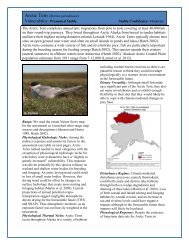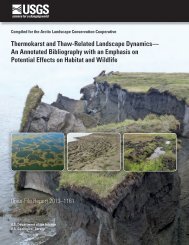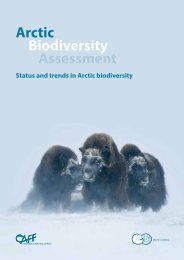Assessing Climate Change Vulnerability of Breeding Birds in Arctic ...
Assessing Climate Change Vulnerability of Breeding Birds in Arctic ...
Assessing Climate Change Vulnerability of Breeding Birds in Arctic ...
Create successful ePaper yourself
Turn your PDF publications into a flip-book with our unique Google optimized e-Paper software.
Executive Summary<strong>Climate</strong> change is occurr<strong>in</strong>g at anaccelerated rate <strong>in</strong> the <strong>Arctic</strong> compared tomost other places on the earth. Temperatureand moisture changes are lead<strong>in</strong>g towarm<strong>in</strong>g permafrost, <strong>in</strong>creased coastalerosion, more frequent fires, and shrub<strong>in</strong>vasion, alter<strong>in</strong>g geomorphology,hydrology, and habitat structure. These rapidchanges <strong>in</strong> habitats, especially thoseassociated with hydrology, are ultimately<strong>in</strong>fluenc<strong>in</strong>g wildlife populations. <strong>Arctic</strong>Alaska harbors some <strong>of</strong> the most importantbreed<strong>in</strong>g and stag<strong>in</strong>g grounds for millions <strong>of</strong>birds represent<strong>in</strong>g over 90 species. Many <strong>of</strong>these species are migratory, w<strong>in</strong>ter<strong>in</strong>g atdisparate sites across the planet, and someare already experienc<strong>in</strong>g population decl<strong>in</strong>esand/or are species <strong>of</strong> conservation concern.As climate change has become a focal issuefor agencies and other <strong>in</strong>stitutions <strong>in</strong> recentyears, one <strong>of</strong> the recognized needs is theapplication <strong>of</strong> science-driven assessments toreconsider landscape management, wildliferesearch, and conservation priorities <strong>in</strong> thiscontext. To help address these emerg<strong>in</strong>gneeds the Wildlife Conservation Societyconducted a climate change vulnerabilityassessment for arctic breed<strong>in</strong>g birds to helpguide climate-<strong>in</strong>formed wildlifemanagement <strong>in</strong> the region. The specificgoals <strong>of</strong> this assessment were to: 1) providea climate change vulnerability rank<strong>in</strong>g for54 <strong>Arctic</strong> Alaskan breed<strong>in</strong>g bird species; 2)evaluate the relative contribution <strong>of</strong> specificsensitivity and exposure factors to <strong>in</strong>dividualspecies rank<strong>in</strong>gs; 3) consider how thisassessment may be <strong>in</strong>tegrated with otherapproaches; and 4) appraise theeffectiveness <strong>of</strong> the NatureServe <strong>Climate</strong><strong>Change</strong> <strong>Vulnerability</strong> Index (CCVI) tool.The CCVI tool was developed byNatureServe specifically to compare theadded vulnerability posed by climate changeto species <strong>in</strong> a region. We assessedvulnerability with reference to changesprojected for 2050 and restricted <strong>in</strong>geographic scope to the Alaska portion <strong>of</strong>the <strong>Arctic</strong> LCC region. The CCVI is aspreadsheet based algorithm that <strong>in</strong>tegrates<strong>in</strong>formation on species sensitivity, directexposure to projected atmospheric changes<strong>in</strong> climate, and <strong>in</strong>direct exposure factors.Direct exposure factors, temperature andmoisture balance change, were <strong>in</strong>corporatedas geospatial <strong>in</strong>puts. We ran the tool withdata from five global circulation models,two emissions scenarios, and at two spatialresolutions. Indirect exposure factors<strong>in</strong>cluded sea-level rise, dispersal relative tobarriers, and human mitigation <strong>in</strong> responseto climate change. Sensitivity factors (lifehistory traits mak<strong>in</strong>g a species more or lessvulnerable) were scored by species expertson survey forms based on publishedliterature and their personal knowledge.The CCVI results ranked two species ashighly vulnerable (Gyrfalcon, CommonEider), seven as moderately vulnerable(Brant, Steller’s Eider, Pomar<strong>in</strong>e Jaeger,Yellow-billed Loon, Buff-breastedSandpiper, Red Phalarope, RuddyTurnstone), and five as likely to <strong>in</strong>crease(Savannah Sparrow, Lapland Longspur,White-crowned Sparrow, American TreeSparrow, Common Redpoll). Theassessment outcome suggests that the mostimportant contributions to the climatechange vulnerability for the 54 bird species<strong>in</strong>clude: 1) be<strong>in</strong>g a specialists <strong>in</strong> at least onelife history trait and/or hav<strong>in</strong>g a strongcoastal orientation; 2) the quality and nature<strong>of</strong> <strong>in</strong>teractions with other species; 3)restrictions associated with physical habitatand diet; 4) dependence on other species tomeet habitat needs; and 5) changes <strong>in</strong>disturbance regimes that would negativelyaffect the speices. Physiologicalhydrological niche (i.e., dependence onwetland habitats <strong>in</strong> the arctic) was thought to1








